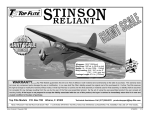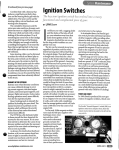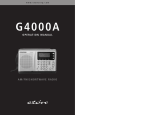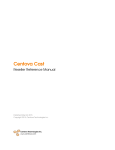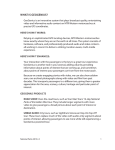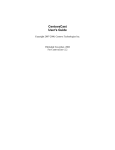Download Stinson 108 Radio - Westin`s Stinson 108 Page
Transcript
Factory Stinson 108 Radio Equipment http://www.westin553.net By Larry Westin - June 28, 1998 UPDATED - Rev B - 10/05/14 - Page 1 of 7 Today it’s unusual for an airplane to fly without a two way radio. In fact more often than not general aviation airplanes now have multiple radios. When the Stinson 108 was in production, 1946 to 1948, radios were not that common in light airplanes. Just a few years before, pre WWII, only a luxury model light plane had a radio. Most aircraft manufactures after WWII offered radios as optional equipment. Other than Stinson 108's, only a few models, such as the Beech Bonanza, included a radio as standard equipment. Since many of the immediate post WWII light airplanes were very basic, often without an electrical system, a number of aircraft radios of the period were dry cell battery powered. Several manufactures offered receiver only radios. All Stinson 108's were delivered from the factory with a two way radio and aircraft electrical system (battery and generator) as standard equipment. During Stinson production two different type radios were installed, the General Electric model AS-1B and the Hallicrafters model CA-2 Skyfone. Stinson installed both radios in the same location, the lower left instrument panel (this was before the days of center mounted radios). General Electric AS-1B radios were installed in model 108 airplanes with serial numbers 108-1 through 108-742. GE AS-1B’s used 12 vacuum tubes with a single crystal controlled transmitter frequency of 3105 KC, producing 12 watts, amplitude modulated. The tunable receiver had two bands, “Range” (200-420 KC), and Standard AM Broadcast (550-1500 KC). The Range scale had a “T” to designate the standard tower to plane frequency of the period, 278 KC. A function switch allowed selection of either the reception/transmit wire antenna or the loop antenna. The transmitter used only the long wire antenna with a loading coil. A filter was included to eliminate morse code reception on the range band, so the voice of a ground station could be heard more clearly. The morse code identifier was the primary station identifier but interfered with voice reception if not filtered. This is a General Electric AS-1B radio, a popular unit in the late 1940's, which came standard with the straight Stinson model 108. One transmitter frequency of 3105 KC (later the FCC required a change to 3023.5 KC). Tunable receiver in the 100 to 420 KC on band 1, and 550 to 1500 KC on band 2. Note the “T” on the upper scale, this marked the standard tower transmitting frequency of 278 KC. Rarely is a tunable radio dial completely accurate. Determining that you were listening to the correct station demands pilot radio knowledge and expertise. A far cry from modern crystal controlled synthesized radios. All Stinsons included two antennas as standard. A long wire from the top of the cabin to the top of the vertical stabilizer for reception and transmitting, and a fixed loop antenna inside the fabric covered fuselage for manual direction finding (you literally had to turn the airplane to determine direction to station). The image at the right shows a Stinson model 108 with the fabric removed. On the fuselage longerons are 4 hooks. Wrapped on the 4 hooks is a loop wire antenna, see yellow arrows, which was used by both the General Electric AS1B, and the Hallicrafters CA-2 radios in the “Range Loop” or “Broadcast Loop” mode to home onto a non directional radio beacon (NDB), or a standard AM broadcast station. Like a modern ADF the loop mode could not be used to fly the “beam” of a 4 course range. To fly the 4 course beam on a radio range the mode was set to “Range Ant” which used the long wire antenna. Many period photographs show a manually rotatable loop antenna above the cabin. Apparently this was an option as all Stinson airplanes were built with the aluminum support bracket for the manually rotatable loop. Loop antennas, both fixed and manually rotatable, were receive only. Also included as standard were the required radio power supply, an antenna loading coil, microphone jack, headphone jack, a model 210-S microphone and a cabin speaker. Total weight of the AS-1B installation was about 13 pounds. Stinson switched to the Hallicrafters model CA-2 Skfone beginning with the model 1081, serial number 108-743, and used the CA-2 through the end of Stinson 108 production, which was 108-3 serial number 108-5260. Hallicrafter’s CA-2 Skyfone radio was self contained and did not use an external power supply. All other items used with the GE AS-1B, antenna loading coil, microphone jack, headphone jack, a cabin speaker and the model 210-S microphone were also standard with the CA-2 installation. Hallicrafter’s CA-2 had one unique feature to help overcome the limitations of tunable receivers. Rotating the receiver band/antenna select switch to “tower” automatically set the receiver to 278 KC. The pilot then transmitted from the airplane to the ground on 3105 KC and listened on 278 KC. Not all towers transmitted to the airplane on 278 KC, Stinson 108 Factory Radio - by Larry Westin - Rev B - 10/05/14 - Page 2 of 7 in which case you had to select “Beacon Ant” (Hallicrafter used the term “Beacon” to designate the 200 KC to 420 KC frequency band) and manually tune the frequency as with other tunable radios. Weight of the CA-2 was a little under 12 pounds in advertisements but the Stinson 108 equipment list shows the weight at 9 pounds. Hallicrafters also changed the face design of the CA-2 to match the etched aluminum lower instrument panel pieces of the later Stinson 108 instrument panels. Fig 1 - CA-2 missing black label Fig 2 - CA-2 with black label Stinson models 108-1, 108-2, 108-3 and 108-4 have the Hallicrafters CA-2 as standard. Fig 1 above is a clean CA-2 with the etched aluminum faceplate, however the selector label is missing. Fig 2 above was taken recently of a Stinson 108-2 which still had the CA-2 radio installed, however it had been sitting outside for a long period with the aluminum case corroded. Fig 2 is included to show the selector options (black) label. The fixed loop antenna remained the same as the AS-1B for all Stinson models. As with the Stinson 108, Stinson 108-1 and 108-2 models continued to use the single wire reception/transmit antenna from the top of the cabin to the top of the vertical stabilizer. An antenna loading coil was located at the top of the cabin below the antenna insulator. Stinson 108-3's used a “V” wire reception/transmit antenna. The “V” antenna wire ran from wingtip to vertical stabilizer, to the other wingtip. Connection to the radio still came from the top of the cabin. A lead in wire attached at the top of the insulator on the cabin had the other end of the lead in wire attached to the “V” wire on the right side of the airplane. To make it possible to hangar the airplane, Stinson 108-3's included quick disconnects on each wingtip reception/transmit antenna wire. Stinson suggested that when the antenna wires were removed from the wing tip they should be attached to the door. Any pilot seeing an antenna wire attached to the door would know the airplane was not ready for flight. A fair number of visitors to my homepage have questioned me about the wing tip antenna brackets. Apparently quite a few shops decided not to take the time to remove these wing tip antenna brackets even though later VHF equipment rendered them obsolete. Stinson 108 Factory Radio - by Larry Westin - Rev B - 10/05/14 - Page 3 of 7 A loading coil was necessary because low frequencies, such as 3105 KC, require a long antenna. The loading coil connected to the wire antenna for transmitting at the top of the cabin insulator. The loop antenna, either fixed or manually rotatable, was only used for receiving. One selling point of the Stinson 108 was the quiet cabin. Advertisements often mentioned how the extra sound proofing kept the cabin so quiet headphones were unnecessary. During this time, the late 1940's, a great many airplanes, Piper J-3's and PA-11's, Cessna 120 and 140's, etc. had little if any sound proofing. Personally I believe Stinson’s low noise claims were a little optimistic. Stinson literature conceded that better reception occurred when using headphones. Headphones were required for all loop direction finding operation. Hand held microphones were the only type available. Many aircraft used, and almost all movies and period literature depict, a Signal Corps T-17 “lollipop” microphone. Stinson actually included a model 210-S microphone as standard equipment. Headsets, with combined headphones and boom microphones, so common today, were not available in the late 1940's. While all radios were delivered with a single crystal to transmit on 3105 KC, this frequency was later changed by the FCC. Sometime in the late 1940's or very early 1950's the FCC decided all light airplane low frequency radios must transmit on 3023.5 KC. All original standard Stinson radios I have seen have been modified to use the 3023.5 KC transmit frequency. Navigation using the Stinson 108's standard radio was possible with either radio by either of two methods. First direction finding using the fixed, or if installed, manually rotatable loop antenna. It was possible to direction find on either a Non-Directional Beacon (NDB) or standard broadcast station. Four course ranges did NOT allow direction finders to work correctly due to the signal patterns needed to generate the four courses. The more common method of radio navigation circa 1940's was use of the A-N four course range. IFR flight during this time period, late 1940's through early 1950's, required use of the four course range. Major advantage of four course radio range navigation was that only a radio with a low frequency range receiver (200-420 KC) with a long wire antenna was necessary. Presentation to the pilot was strictly aural. One side of course the pilot heard a morse code A (. -), on the other side of course the pilot heard a morse code N (- .). When “on the beam” (each station had 4 beams or courses radiating in different directions) the two signals merged to form a steady tone. One major problem with four course ranges was the 200-420 KC frequency used to transmit was very susceptible to heavy static under adverse atmospheric conditions. Just for a moment take yourself back in time a few years, to say 1950. Imagine flying your Stinson 108, at night or in the rain, navigating by four course radio range, all the Stinson 108 Factory Radio - by Larry Westin - Rev B - 10/05/14 - Page 4 of 7 while having to listen for the tone of a radio beam aggravated by static. Night flying presented other problems. Every night the ionoshpere layer surrounding the earth lowers in height; low frequency radio waves begin to skip and bounce back to earth. Radio transmissions from stations far away often interfere with the station you were tracking. The skip of radio waves in the lower frequencies can still be encountered in a car using an AM radio at night. A far cry from the GPS system on the panel today. Pilots who learned to fly using only today’s vastly superior VHF radios to communicate and navigate, may not appreciate the additional pilot skill required to operate the lower state of the art radios which came standard with the Stinson 108. Both AS-1B and CA-2 radios used vacuum tubes for amplification (this was before transistors). Both radios required only a 12 volt input and both used a vibrator to produce the needed B+ high voltage (about 250 VDC in these radios) essential for the vacuum tube anode plates. If tube type radios are a little before your time I should also mention that dry cell battery powered portable tube type radios, common until the late 1950's, also needed a high B+ voltage. As was typical with all portable tube type radios of the time, they usually needed 3 different batteries. An “A,” “B” and “C” battery. The “B” battery was the high voltage source, often a 90 volt battery. Some portable aircraft radios weighed as much as 15 pounds. List price for the General Electric AS-1B, as shown in advertisements, was “under $200.” List price of the Hallicrafters CA-2 Skyfone was shown as $129.95. Lower price, an easier installation and the availability of the matching face plate may have all been reasons Stinson switched from the General Electric AS-1B to the Hallicrafters CA-2. Just as Stinson 108 production ended, the era of VHF radios was arriving. Four course radio ranges operating in the 200-400 KC frequency range were a pre WWII development. Shortly after WWII a newly formed company by the name of National Aeronautical Corporation, more commonly known as Narco, received a CAA contract to develop a VHF navigation radio for light airplanes. Narco’s VRA-1 VHF receiver with omni range was a first for light aircraft. VHF and the associated omni range navigation is so superior that it quickly displaced the earlier low frequency 4 course range. Omni’s visual indicator being much easier to interpret then the aural signal of the low frequency four course range. Another major advantage is that omni provides 360 “beams” (or radials) as compared to four for the low frequency range. In addition VHF radio waves are far less susceptible to static and the higher frequency does not bounce or skip off the ionoshpere, eliminating interference from distance stations at night. By the early 1960's most low frequency 4 course ranges were decommissioned. Omni’s advantages were so strong that by this time most Stinson 108's had the original radios replaced. Some owners moved the low frequency radios to right side of the panel as a backup while typically installing a Narco Superhomer or Omnigator, Lear LTRA-5 or Stinson 108 Factory Radio - by Larry Westin - Rev B - 10/05/14 - Page 5 of 7 other similar VHF radio, on the left side. By the way if you’ve never flown a Lear LTRA-5 omni (invented by the same Bill Lear of Learjet fame), its presentation was quite unique compared to other omni indicators. It used a 3 inch oscilloscope type display to present the omni navigation information to the pilot. A green circle appeared on the oscilloscope screen and the omni radial you were on appeared as a small blip at one point of the circle. Something like a RMI indicator but without the aircraft heading information included. Lear advertisements show this oscilloscope type display was also available with the LTRA-6. All LTRA-6's I ever saw had a needle omni indicator, but even here Lear decided to be different. The needle was upside down compared to other omni indicators. One physical difference between the standard low frequency radios and the later VHF radios is the width of the unit. The low frequency radios were quite narrow by today’s standard. VHF radios like the Narco Superhomer or Omnigator, or the LTRA-5 are about an inch wider then the low frequency radios. Today’s solid state VHF radios such as the Narco MK-12D and King/Bendix KX-155 are also wider then the standard Stinson low frequency radios. In the Stinson 108 airplanes it is almost always necessary to angle the newer radios to avoid interference with the flight controls, especially elevator up movement. Rather a major consideration I might add. Another advantages of VHF included multi frequency transmission. Where the original Stinson radios could only transmit on 3105 KC (later 3023.5 KC), the new VHF radios typically had 4 to 12 transmitter frequencies available. Still one crystal was needed for each frequency. (Today’s solid state aircraft radios use a frequency synthesizer which needs only a single crystal to create 760 different transmitter frequencies!) As more and more light planes flew it became increasingly important not to have everyone transmitting on the same frequency. Early VHF radios allowed you to transmit to tower on 122.5, to CAA Radio (now Flight Service) on 122.1, and emergency on 121.5. Early VHF radios rarely used simplex operation (transmitting and receiving on the same frequency). Prior to VHF almost all light airplanes transmitted to all ground stations on only 3105 KC (or later 3023.5 KC). Some low/medium frequency aircraft radios in light aircraft had the capability to also transmit on 6210 KC, but these were rare. VHF’s vast improvements rendered the standard Stinson low frequency radios obsolete only a few years after they were built. Most Stinson owners installed VHF radios well before normal wear and tear would necessitate replacement of the low frequency radio. Finding original Stinson radios today is more difficult than finding original Stinson or Franklin parts. Stinson 108 Factory Radio - by Larry Westin - Rev B - 10/05/14 - Page 6 of 7 Bibliography for this article: Flying Magazine, “Lightplane Radio Review” - September 1946 issue, pages 38 to 40. General Electric Company, “Personal Plane Radio Type AS-1B” - Aug. 1946. Operators manual for the AS-1B Radio. Graybill, Harry, “Every Pilot’s VHF” - Skyways magazine, July 1949. Stinson Division of Consolidated Vultee Aircraft, “Cording Diagram, Radio AS-1B" drawing number 108-3031510 - dated 10/3/45. Stinson Division of Consolidated Vultee Aircraft, “Stinson flying Station Wagon and Stinson Voyager Owner’s Operating Manual, 1948" - copyright 1947. Stinson Division of Consolidated Vultee Aircraft, “Stinson model 108 Series Airplanes General Service Manual" - copyright 1947. If you have corrections or additional information about the Stinson 108 standard radios, please contact me. Postal Address Larry Westin 21721 Verde St Tehachapi, California U.S.A. 93561-9437 Phone (661) 823-4707 E-Mail Larry Westin [email protected] Stinson 108 Factory Radio - by Larry Westin - Rev B - 10/05/14 - Page 7 of 7








